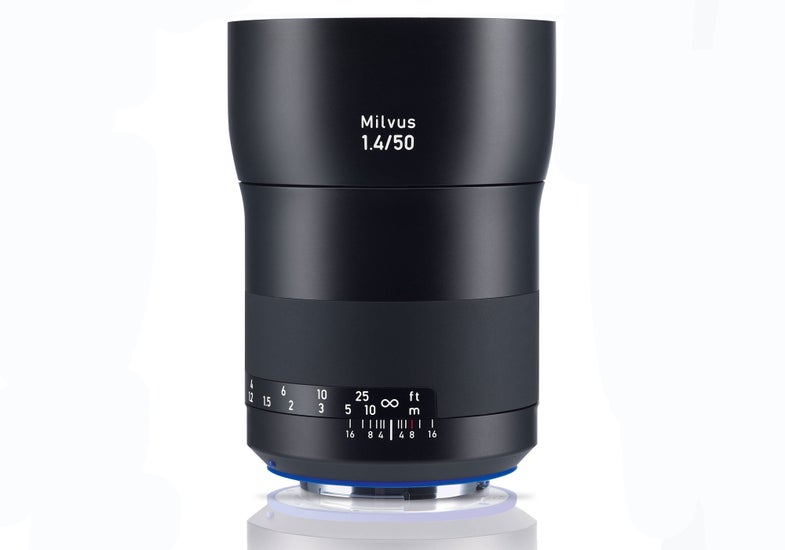Lens Test: Zeiss Milvus Distagon T* 50mm f/1.4
This manual focus 50mm lens is one beautiful bird

We may earn revenue from the products available on this page and participate in affiliate programs. Learn more ›

Last month we tested the first of the new full-frame Zeiss Milvus lenses, the 85mm f/1.4, and loved its sharpness and lack of distortion. This month we test another one, the Zeiss Milvus Distagon T* 50mm f/1.4, which hit the street at $1,199. It has 10 elements in 8 groups, with a floating element design to drive high image quality throughout the focusing range. Zeiss says it made the Milvus line specifically for new ultra-high-resolution DSLRs to handle 6K video natively and churn out images in the 50MP range.
The Milvus 85mm was optically and financially right in the middle of Zeiss’s Otus and Classic (as the company now calls it) 85mm lenses. Similarly, here we compare the Milvus 50mm ZE to the high-end Otus 55mm (tested in 2014) and Classic Planar 50mm f/1.4. We also tested it against other full-frame 50mm f/1.4 glass from Canon, Nikon, Sigma, and Sony, as well as Rokinon, which, like Zeiss, allows manual focus only.
In the field, it felt heavy for a 50mm. It is at least a pound heavier than the Canon, Nikon, Sony, and Zeiss Classic, and it weighs a few ounces more than the Rokinon and Sigma; it is about 6 ounces lighter than the Otus. While it is shorter than the Otus and the Sigma, it is also longer than all of the others.
This Milvus produced smooth and clean bokeh, especially with the aperture wide open. The level of contrast we saw in our photos in field use rendered subjects very realistically. Its excellent multi-coat- ing suppressed most lens flare, and what flares did show up were mild.
The construction is top-notch. Its metal-clad body is weather-sealed to protect against dust and moisture. The focus ring, while well damped, has a turning radius that’s quite long at 220 degrees. Once you’ve found your focus, however, the lens is really sharp and crisp, as our lab tests show.
In our SQF test on the optical bench, the Milvus was slightly out-performed by Zeiss’s own Otus. But it scored a bit better than the Classic and slightly better than the rest of the lenses we tested, reaching Excellent at our 11×14 benchmark for sharpness and contrast.

In our distortion tests using DxO Analyzer 5.3, the Milvus ranked in the Slight pincushion range at 0.19%—not quite on par with the Milvus 85mm and Otus 55mm (0.09%) or the astonishing Sigma 50mm (0.02%). It scored slightly better, though, than the Zeiss Classic and Canon (both 0.24%) and the Sony (0.26%), and significantly better than the Rokinon (0.32%).
With vignetting, we found an opposite pattern. The Zeiss Classic and Sigma tested a little better than this Milvus, with light falloff gone by f/2. But falloff in the Milvus and Otus were both gone at f/2.5, better then the rest of the lenses we’ve tested. In close focusing and maximum magnification, all the lenses fell in line similarly, with the Milvus performing just slightly better than the Otus.
So this 50mm Milvus indeed occupies a middle ground between the Otus and Zeiss Classic lenses in both optics and price. It sells for about $2,600 less than the very pricey Otus; the Classic now streets for just $625. With the addition of this line, Zeiss offers a nice range of options. The question is what bird will Zeiss choose for its next series of great lenses?

Tech Specs: F/5.6 for 1/50th sec. at ISO 100

Tech Specs: F/4.5 for 1/200th sec. at ISO 160

Tech Specs: F/4.5 for 1/200th sec at ISO 160

Tech Specs: F/8 for 1/160th sec. at ISO 800

Tech Specs: F/2 for 1/2,500th sec. at ISO 800

Tech Specs: F/2.8 for 1/1,250th sec. at ISO 200

Tech Specs: F/2.8 for 1/1,250th sec. at ISO 200

Tech Specs: F/1.4 for 1/800th sec. at ISO 200

Tech Specs: F/1.4 for 1/800th sec. at ISO 200

Tech Specs: F/1.4 for 1/800th sec. at ISO 200

Tech Specs: F/1.4 for 1/400th sec. at ISO 100